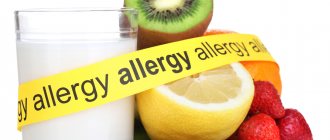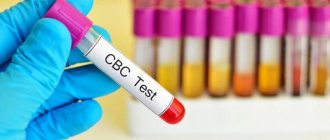A food allergy is a condition where the body reacts to a certain food as if it were a harmful substance. Both children and adults suffer from food allergies. But while a child’s allergy to any product may go away with age, an adult’s allergy, unfortunately, remains.
How do food allergies manifest? What foods to exclude from the menu to prevent an allergic reaction? How to treat food allergies? Let's try to answer these and other questions...
The most common allergens
Products that most often cause food allergies:
- eggs;
- nuts (hazelnuts, almonds, peanuts, etc.);
- fish;
- citrus fruits (oranges, tangerines, etc.);
- berries (strawberries, wild strawberries, etc.);
- chocolate;
- milk;
- legumes (soybeans, beans, peas, etc.).
- nutritional supplements.
Allergens found in some foods may be similar to pollen allergens. This is called cross allergy. For example, wormwood pollen is a cross-allergen for peppers, carrots, mustard, bananas, and citrus fruits. This means that a patient with hay fever may also have food allergies.
What foods cause allergies?
An allergic reaction can develop when eating any product. However, there are a number of products that have increased allergenic properties.
According to the degree of allergenic activity, three groups are distinguished:
- high
(cow's milk, fish (especially sea fish), citrus fruits, eggs, seafood (oysters, crustaceans, shellfish), mushrooms, nuts (especially hazelnuts), chicken meat, strawberries, wild strawberries, chocolate, coffee, cocoa, mustard, persimmon, melon , pineapple, pomegranate, blackberry, black currant, tomato, carrot, rye, wheat, celery, etc.); - medium
(peaches, apricots, red currants, rabbit, pork, rice, corn, buckwheat, green peppers, peas, potatoes, etc.); - low
(lamb, horse meat, plum, watermelon, bananas, turnips, pumpkin, etc.).
An allergic reaction can be caused not by the product itself, but by additives used to improve taste, color, smell, increase shelf life, food coloring, additives, and genetically processed foods.
It should be remembered that people suffering from hay fever (allergy to pollen) often experience cross food sensitivities. There are a number of products that have similar structures to causally significant allergens (pollen from trees, cereals and weeds), and the consumption of which increases the allergic reaction.
Allergy and Enterosgel
In the development of allergies, the key factor is the contact of the allergen (some substance in the air, food, clothing, etc.) with the body. Accordingly, minimizing or eliminating such contact prevents the development of the reaction, which explains the effectiveness of Enterosgel.
It is known that the intestines play a critical role in the functioning of the immune system. Enterosgel removes allergens from the gastrointestinal tract. In addition, Enterosgel removes bacterial endotoxins, promotes the regeneration of damaged mucosa and normalizes the intestinal microflora.
Thus, the functioning of the intestines and immune system is restored, and allergic manifestations are reduced. At the first signs of a possible allergy, you can take Enterosgel in a standard dose. Then use the drug according to the instructions for 1-2 weeks.
Need to know
The body's rapid and violent reaction to a food allergen is called anaphylaxis (anaphylactic shock). As a rule, anaphylaxis manifests itself 1-2 hours after the food allergen enters the body. It causes the tongue and throat to swell, breathing becomes difficult to the point of suffocation, vomiting occurs, blood pressure decreases, and the person loses consciousness. If you suspect anaphylactic shock, call an ambulance immediately!
In recent years, food allergies have become quite common. The most severe allergic reaction occurs to peanuts. Scientists conducted a study in which genes “responsible” for food allergies were found and studied. In 20% of cases it is a peanut allergy!
Causes of the disease
The main factors contributing to the development of food allergies are:
- hereditary predisposition;
- the intake of antibodies in the prenatal period and through human milk (if the mother’s nutrition is disrupted during pregnancy and during breastfeeding, i.e. excessive consumption of foods with increased allergenic properties);
- early transfer of the child to artificial feeding;
- malnutrition of the child, expressed in the discrepancy between the volume and ratio of food ingredients to the age and weight of the child;
- increased permeability of the intestinal mucosa, which develops with inflammatory diseases of the gastrointestinal tract (for example, peptic ulcer of the stomach or intestines, chronic gastroduodenitis, biliary dyskinesia, enzymopathy, etc.);
- changes in the composition of intestinal microflora;
- low acidity of gastric juice.
What a hello, what a response
An allergic response to any food component depends on our immune system and hereditary predisposition. Immune cells produce antibodies in response to the introduction of an allergen into the body.
The reasons for the development of allergies may be associated with the action of negative factors (for example, air pollution from exhaust gases or industrial waste). Food allergies to certain foods can be a consequence of problems in early childhood. For example, early refusal of breastfeeding, improper introduction of complementary foods, feeding with foods containing excess dyes, preservatives and other “chemicals”. It’s even worse if a breastfeeding mother does not keep a food diary - in this case, it is much more difficult to figure out what exactly caused the child’s allergies. As a result, the child develops diathesis - allergies on the face, skin of the neck, and limbs.
Interesting fact
After many years of observations, Japanese pediatricians found that first-born children suffer from allergies more often than younger children. Unfortunately, there is no scientific explanation for this phenomenon yet.
Most immunologists are confident that allergies are an “erroneous” reaction of the body to substances that are harmless to other people. Some adhere to a radically opposite theory, arguing that it is allergies that protect the body from foreign substances, for example, xenobiotics. According to this theory, in the process of evolution, allergic reactions developed in response to the emergence of a large number of new substances in the world around us. Perhaps, in this way, if you are allergic to plant pollen, the body warns its owner about their toxicity?
From this position, allergic reactions even benefit the body - a person avoids contact with allergens in the future and reduces their harmful effects on health. Do not forget that the line between benefit and harm is sometimes very thin. By consuming substances that are harmful to yourself and thus provoking signs of food allergies, you can bring the body into anaphylactic shock!
However…
British scientists have found that for 20% of their compatriots, food allergies are just a fiction that justifies laziness, excess weight, rashes on the body, and reluctance to eat right or exercise. In fact, only 2% of them have a food allergy (ICD 10 code - T78.1).
Complications
The most severe complication from strong food allergens is anaphylactic shock. It develops due to hypersensitivity to certain foods or ignoring the first signs for a long time. The entry of an allergen into the human body leads to increased symptoms and further development of shock. The authors Pampura and Khavkin come to the conclusion that “in some patients, anaphylaxis appears only if physical activity is preceded by the consumption of a certain product” (Pampura A.N., Khavkin A.I., 2003, p. 1126).
If the allergy is manifested by vomiting and diarrhea, then prolonged contact with the allergen leads to electrolyte disturbances. They, in turn, often require correction in a hospital setting and also threaten human life and health.
Other complications include the addition of a bacterial infection when scratching the skin, the formation of cross-allergy to pollen or household dust.
Types of food allergies
Based on time and nature, the following forms of manifestation of food allergies are distinguished:
- Sudden - when consuming a product that has not previously caused an allergic reaction, numbness in the mouth, allergies on the face (in the form of redness of the skin), nasal congestion, swelling of the tongue suddenly appear;
- Persistent food allergies in adults, the symptoms and treatment of which we will consider a little later. This reaction occurs constantly in response to the consumption of prohibited foods and, if the diet is not followed, requires regular therapy;
- Hidden - the reaction does not occur immediately, but as antibodies accumulate to certain allergens.
- Severe food allergies. Symptoms occur immediately in response to the consumption of an allergen product.
Foods and additives that cause allergies
Doctors Sidorovich and Luss write that “almost any food product can act as an allergen and cause the development of food allergies. However, the most pronounced sensitizing properties are in products of protein origin containing animal and vegetable proteins” (Sidorovich O. I., Luss L. V., 2021, p. 141). The table shows the most common allergens in food:
| Plant food | Raspberries, strawberries, wild strawberries, black currants, blackberries, pineapple, melon, persimmon, pomegranate, citrus fruits, chocolate, tomatoes, nuts, honey, mushrooms, wheat, soybeans, carrots |
| Animal food | Milk, eggs, fish, crustaceans and seafood, cold processed chicken |
| Supplements | Pesticide residues and agricultural fertilizers in plant foods. Dyes (especially tartrazine, erythrosine, sodium nitrite), flavorings (glutamates), preservatives (benzoates, benzoic acid, sulfites), enzymes, thickeners, emulsifiers, bacteriostatics, flavor enhancers (monosodium glutamate), etc. |
Note that allergen additives provoke so-called false reactions, or pseudo-allergies. In this case, food antigens can act without the participation of allergic antibodies on target cells or activate certain biological systems; they are not based on immune reactions.
An increase in the level of histamine in the blood may not be associated with a true allergy, but with the consumption of foods containing it in large quantities: fermented cheeses, sauerkraut, dried ham, canned food, spinach.
Risk factors for food allergies in adults
Allergy symptoms and treatment depend on factors such as:
- nature of the allergen;
- age of the person at first contact with the allergen;
- other allergic reactions (eg, hay fever, contact allergy);
- diseases of the digestive system;
- type of contact with the allergen (first or repeated);
- state of intestinal microflora.
Hidden danger
If you are allergic to fish, never lick postage stamps when sending mail! The fact is that the reverse side of the stamp is covered with glue, which is made from fish bones. They licked it, stuck it on, and please - food allergies, allergies on the face, torso, limbs.
Symptoms of the disease
Food allergies often appear within a few minutes of consuming the product. There is a rash, itching, redness, swelling of the skin of the hands, face and neck. Many people complain of a sore throat, heartburn, and bloating. Children and adolescents are at high risk of anaphylactic shock, acute urticaria, eczema, and asthma.
In adults, the following symptoms most often develop:
- chronic urticaria;
- atopic dermatitis;
- rhinitis and conjunctivitis;
- gastritis;
- migraine;
- dermatitis.
According to statistics, skin manifestations are observed much more often. The rash is usually erythematous in nature. Elements of the rash can be located on any part of the skin. Dermatological manifestations persist from several hours to several days, then disappear on their own provided there is no further contact with the allergen.
When it enters the body again, the allergy develops again. There is a possibility that each episode will be more severe and intense.
Food allergies cause gastrointestinal problems within the first hours. The following symptoms are usually noted:
- stool disorders;
- abdominal pain, bloating;
- vomiting
With high allergic readiness, these symptoms develop already at the time of consumption of the allergen. It happens that dyspepsia is accompanied by immediate swelling of the mucous membranes of the mouth, lips, and tongue; nasal congestion.
Some varieties of fish, strawberries, and peanuts cause the most severe systemic reactions - angioedema, anaphylactic shock.
People suffering from bronchial asthma or food allergies often experience an attack that develops as a cross-allergy. Headaches, fatigue, and weakness appear after eating potentially dangerous foods.
A few words about our smaller brothers
It turns out that animals also suffer from food allergens. For example, food allergies in cats occur regardless of gender, breed and age. The main signs are itchy skin, hair loss, scratching on the skin.
Most often, food allergies in cats occur to soy, gluten, seafood, beef, dairy products, and lamb.
In its manifestations, food allergies in purebred dogs are no different from food allergies in dogs – “ mongrels”:
- itching, pimples on the scalp, abdomen, paws;
- discharge from the eyes, nose, ears.
But let's go back to the representatives of the species Homo Sapiens, or, more simply, to people.
What does an allergy look like on the face?
There are many manifestations of allergies, and they depend on the form, location and intensity. The main indicator of the disorder is sudden swelling of the eyes and lips, one or both. Changes also affect the structure of the skin. It becomes lumpy, swollen, with a small scattering of small dots. Red, uneven spots of varying sizes often appear. Cracks and a scaly structure may be observed. If you give in to temptation and start scratching the itchy areas, the condition will quickly worsen.
Depending on the type of disorder and the affected area, allergic rashes on the face are likely, the treatment of which requires an integrated approach. Along with pharmaceutical drugs, cosmetics have a fairly good effect. Plasma therapy with the Japanese drug CURACEN perfectly restores appearance, but only after the acute period ends and the condition stabilizes.
What are the symptoms of food allergies in adults?
More often, an immediate response from the body occurs immediately after consuming the allergen product. Sometimes (although less frequently) symptoms appear after several hours or days.
What does a food allergy look like:
- numbness and swelling of the tongue, lips and oral mucosa;
- itching of the skin and oral mucosa;
- difficulty swallowing;
- acne on the skin;
- clear nasal discharge;
- nausea, vomiting;
- allergy on the face in the form of redness;
- sneezing, dry cough;
- colic in the stomach,
- diarrhea (diarrhea).
What factors determine food allergies in adults? Symptoms and treatment of the disease depend on concomitant diseases. For example, scientists have proven a direct connection between food allergies and... diabetes. It turns out that food allergies provoke inflammation in the pancreas and tissue resistance to insulin.
Food allergies, food intolerances and pseudo-allergies
There are various reasons why food can make you feel worse, the most common being food allergies and food intolerances. What both allergies have in common is that they involve the immune system. However, there are some differences in how the immune system carries out its response and what changes this leads to. Immunoglobulins
are specific proteins produced in response to antigens. The main function of immunoglobulins is to bind and remove dangerous antigens: bacteria, viruses, allergens. Immunoglobulins are also known as antibodies. There are five main types of antibodies (Ig): A, G, M, E and D. B cells, a special type of white blood cell, produce antibodies by switching their production from one type to another. B lymphocytes are part of the adaptive immune system.
Immunoglobulins mediate the secondary immune response.
Classic IgE food allergy
Classic allergies occur when the immune system produces specific IgE antibodies. Antibodies of subclass E lead to an immediate allergic reaction.
A typical example of an allergic reaction is a food allergy to peanuts. When a person with an allergy eats peanuts for the first time, B cells are exposed to peanut allergens. B cells begin to produce IgE antibodies to fight the peanut “infection.” To the body, peanuts represent poison, not food.
IgE antibodies are created specifically to protect the body from peanuts, and are therefore called specific. Peanut IgE antibodies bind to allergens and attach to mast cells. Mast cells are a type of white blood cell that contain histamine and other inflammatory markers. The inflammatory response is designed to protect the body by limiting the action of the allergen.
In mast cells, IgE antibodies wait until the next interaction with peanuts. When a person repeatedly consumes peanuts, IgE antibodies signal mast cells to release histamine and other compounds. Histamine and other compounds cause allergy symptoms such as itching, inflammation, and swelling.
Allergy symptoms appear within seconds or minutes of contact with the allergen: itching, rash, watery eyes, severe swelling, difficulty breathing, or anaphylactic shock in severe cases.
Symptoms can be seasonal, as with allergies due to pollen or mold, or year-round, as with food allergies. Allergy symptoms can range from mild to severe. Allergic reactions pose a particular danger to children, since their immune system is finally formed only by 8–12 years of age.
The total IgE test is performed as the first level test for allergy screening. Elevated values indicate the allergic nature of the disease or parasitic infections. The next step is to determine specific IgE. These tests are needed to confirm the allergic nature of the disease. If a person is suspected of having an allergy to several food components, it is recommended to undergo a full allergological examination.
Food intolerance
Food intolerance is an adverse reaction to a food without an antigen-antibody response. Food intolerance is a collective term that unites various conditions, but in which the same symptoms are observed as in classic allergies.
Food intolerance has similar symptoms to allergic reactions, but delayed in time. Symptoms may appear immediately or 1–3 days after eating the trigger food. Therefore, the connection between food and reaction is not always so noticeable.
The immune system does not take part in the mechanism of development of food intolerance. Food intolerance reactions are not an independent disease, but only mask a deeper problem. Only a doctor can figure out the reasons.
The difficulty in diagnosing food intolerance lies in the delayed symptoms of the disease and lack of specificity. Symptoms may appear immediately or three or more days after eating the trigger food. Clinical manifestations range from headaches and nausea to depression, anxiety and hyperactivity, or fatigue, bloating or mood changes after eating. Dark circles under the eyes, not related to sleep-wake patterns, also indicate a negative liver reaction to food, especially in children. Most people live with these symptoms, sometimes for years.
Adults are more susceptible to developing food intolerances than children. As a rule, people with pathologies of the gastrointestinal tract, metabolic disorders, and smokers constitute a risk group for food intolerance.
It is difficult to determine which food causes which symptoms due to delayed reactions. The IgG test helps localize and limit the list of triggers.
Not all food intolerances are related to the immune system. It is therefore not always inappropriate to associate IgG with food intolerance in general.
The most common cause of food intolerance is enzyme deficiency. In children, enzyme deficiency is the result of immature enzyme systems; in adults, it is a result of pancreatic pathology, inflammatory bowel disease, and autoimmune conditions.
Deficiency of certain enzymes in the gastrointestinal tract leads to adverse reactions such as flatulence.
Symptoms of flatulence:
- diarrhea;
- bloating;
- skin rash;
- headache;
- nausea;
- fatigue;
- stomach ache;
- runny nose.
Celiac disease and lactase intolerance
are two prominent conditions of food intolerance.
The most striking conditions in which a certain relationship has been identified between the foods consumed and the frequency of side effects are celiac disease and lactase deficiency.
Celiac disease or celiac disease
is an autoimmune disease in which the immune system attacks its own tissues. However, this is not an allergy. Reactions caused by gluten affect the villi of the intestinal walls, which leads to their atrophy.
Lactase deficiency involves a deficiency of the enzyme lactase, which breaks down milk sugar. This enzyme is active in young children because they are predominantly breastfed. In adults, enzyme activity decreases and this is considered normal. Due to the fact that enzyme activity decreases, side effects occur, the severity of which varies from mild to severe. Intolerance occurs due to malabsorption and is associated with drinking a regular glass of milk.
An elimination diet leads to improved well-being.
Other groups of substances that cause abdominal discomfort are tyramine and sulfites. Tyramine-containing foods can cause migraines, and in people taking MAO medications, cause a sharp rise in blood pressure. Sulfites are used as preservatives and are therefore ubiquitous. Sulfites can cause asthma attacks or symptoms such as: abdominal pain, diarrhea, nausea, vomiting, wheezing, hives, swelling.
Pseudoallergic reactions
This type of reaction has similar manifestations as allergies, but differs in different mechanisms of formation.
Pseudoallergic reactions can be explained by the activation of inflammatory or anaphylactic mechanisms not associated with antigen-specific immune reactions. These reactions may be caused by the following agents: direct mast cell activators, complement activators, and nonsteroidal anti-inflammatory drugs. These substances in the human body can cause a number of physiological and pathological reactions, leading to the appearance of symptoms of pseudoallergic reactions, such as nausea, dermatitis, hypotension, and anaphylactic shock. More than 30% of adverse drug reactions are immediate hypersensitivity reactions, and up to two-thirds of all immediate hypersensitivity reactions may be pseudoallergic reactions.
Pseudoallergic reactions are mediated by histamine. Its release from target cells is caused either by the direct action of a food allergen, or occurs through the activation of biological systems - the complement system and the kinin system.
The most common factors in the development of food intolerance are excess intake and production of histamine, increased absorption of histamine due to damage to the intestinal mucosa, and increased release of histamine from target cells. The main cause of pseudoallergy is the increased consumption of foods containing histamine, tyramine, and histamine liberators. Fermented cheeses and wines, sauerkraut, dried ham, sausages, canned fish, tuna - a small list that can trigger pseudo-allergic reactions.
With pseudo-allergic reactions, the amount of food eaten is important - the larger it is, the brighter the clinical manifestations.
What about the children?
Food allergies in a child are a serious problem. Therefore, the main task of parents is to quickly identify the product that causes the allergy and exclude it from the baby’s diet. Food allergies in infants, like food allergies in children 2 years of age and older, are manifested by various rashes: nodules, blisters, pink or red spots. The allergy is located on the face, neck, skin of the extensor surfaces of the joints, torso, buttocks, and itchy skin. The baby eats poorly, sleeps poorly, becomes capricious and restless.
By the way, the statement that a child may be allergic to mother’s milk is nothing more than a myth! Most likely, the baby’s body reacts to allergens that enter the mother’s milk along with food: perhaps the mother ate an egg, fish, chocolate or peanuts the day before...
Various congenital diseases associated with metabolic disorders, for example, phenylketonuria, can also disguise themselves as symptoms of food allergies in children. With such diseases, the body is not able to absorb certain substances - proteins, carbohydrates, etc. The diagnosis can be made through a series of biochemical and genetic studies.
Causes
A child develops a food allergy due to:
- genetic predisposition;
- decreased protective functions of the intestinal mucosa;
- large amounts of food consumed, etc.
In circumstances where tolerance fails, the immune system produces an Ig E antibody response against the specific food. The process begins in the intestines (although it can also affect other areas, such as the respiratory system or skin).
When a patient consumes a “dangerous” product, the antigen associated with Ig E is detected on the surface of basophils and mast cells. At this time, they are activated, and histamine and other inflammatory substances are released.
Food allergies: diagnosis
The diagnosis of “food allergy” is made by a doctor based on a survey of the patient or his relatives (the connection between the symptoms of food allergy and the consumption of a certain product), examination and laboratory test data.
Skin tests are performed. A small amount of liquid that contains the allergen is applied to the skin, after which a small injection or incision is made. If the skin swells at the injection site, like after a mosquito bite, this indicates an allergic reaction, and the size of the rash indicates the strength of the reaction. In addition, immunological tests for food allergies and special tests are carried out.
Price
Allergology-immunology
| Name of service | Price |
| Consultation with an allergist-immunologist, primary | 3 500 ₽ |
Advantages
- The latest, constantly updated equipment
- Interest-free installments for all services
- Online consultations with an ENT doctor
- Visit of an ENT doctor to your home
- Friendly and qualified staff
- 24/7 ENT assistance
A food allergy is an abnormal reaction of the immune system that occurs shortly after eating a certain food. Even small amounts of an allergic food can cause signs of a food allergy, such as digestive problems, swelling and skin marks. In some people, food allergies can cause serious symptoms or even a life-threatening reaction called angioedema (swelling of the airways) - also known as Quincke's edema.
You should not tolerate a condition that can significantly reduce your quality of life. Contact a professional allergist who will determine the source of your food allergy and give competent clinical recommendations.
How to cure food allergies?
Treatment of food allergies is aimed at reducing the symptoms of an allergic reaction, removing the allergen from the body and restoring the intestinal microflora. Accelerates the elimination of toxic products of an allergic reaction by taking sorbents - most often this is the familiar Enterosgel.
In addition, antihistamines are prescribed, and in severe allergies, glucocorticoid hormones.
After identifying the cause of the allergy, a strict hypoallergenic diet is prescribed.
A diet for food allergies involves a complete rejection of foods containing the allergen, as well as smoked foods, marinades and alcoholic beverages. The products are consumed boiled or stewed. What then can a child and an adult do? Casseroles, vegetable soups, cereals, unsweetened tea, crackers, herbal infusions.
This is interesting
Did you know that allergies are afraid of fermented milk products? According to Thai scientists, the best prevention of allergies is a glass of kefir once a day.
- Enterosgel sorbent helps well against allergies: as mentioned above, the drug safely binds and removes allergens, toxins and other harmful compounds from the body, thanks to its unique form, without affecting beneficial substances and microelements;
- For adults, pills for food allergies are selected by the attending physician, taking into account symptoms, concomitant diseases and the form of allergy, so you should not self-medicate. Long-acting antihistamines are considered effective drugs;
- Probiotic preparations protect the intestines and restore microflora;
- For severe forms of food allergies, for example, angioedema, hormonal medications are prescribed.
Treatment
The course of treatment can be divided into two parts: the use of medications when symptoms immediately appear and therapy aimed at prevention. Doctor Luss o (Luss L.V., 2005, p. 140).
Antihistamines are not a panacea, since both with true allergies and with pseudo-allergies, it is important to promptly eliminate risk factors for the development of severe manifestations.
The main ones include concomitant diseases of the gastrointestinal tract, leading to failure of the digestion process, changes in the permeability of the walls of the gastrointestinal tract, and a decrease in the acidity of gastric juice. For this purpose, enzyme preparations, enterosorbents, and probiotics are used.
The most important point after the first measures is to accelerate the elimination of the allergen and prevent further contact with it. The main stages of treatment look like this:
- Symptomatic therapy: taking antihistamines for first aid.
- Elimination of the allergen from the body: prescribing a hypoallergenic diet, pharmacological methods, or a combination of these approaches. If the “provocateur” entered the digestive system recently (several hours ago), enterosorbents will be especially effective. They bind substances in the intestinal lumen, preventing them from further entering the bloodstream. If allergens have been in the body for a long time or a lot of time has passed after a single exposure, elimination occurs naturally, and sorbents will only help in eliminating symptoms.
- Allergen-specific immunotherapy (ASIT). This stage follows only after elimination, comprehensive diagnosis, and accurate identification of the provoking antigen.
ASIT is relevant when irreplaceable dishes are added to the list of those prohibited for consumption; the human body is not provided with everything necessary. This method consists of introducing certain dosages of the allergen, which are gradually increased, which allows the development of immunological tolerance.
Author Luss emphasizes that “the attitude towards ASIT in patients with IPA is not yet clear and contradictory. Basically, preference is given to prescribing elimination diets” (Luss L.V., 2005, p. 140). Perhaps this is due to the need to undergo comprehensive diagnostics and constant long-term treatment when the allergy no longer manifests itself. After all, ASIT can be recommended six months after changing the diet. However, this method is the only option to get everything you need from food when you have allergies.
Nutrition for food allergies
The complex of therapeutic measures necessarily includes a nutritional method. Eliminating the cause—the antigen—is extremely important to improve the condition and prevent exacerbations. A complete avoidance of intolerant foods is expected. For convenience, we have provided a list of permitted and prohibited items in the table:
| Allowed | Prohibited |
| Unfortunate bread | Smoked meats |
| Tea | Vinegar |
| Sugar | Fish |
| Boiled lean beef | Mushrooms |
| Butter and vegetable oils | Bird |
| Fresh cucumbers | Nuts |
| Parsley dill | Whole cow's milk |
| Watermelons | Honey |
| Baked apples | Nuts |
| One-day fermented milk products | Fruits and berries: strawberries, melon, pineapple, citrus fruits |
| Cereals: rice, buckwheat, oatmeal | Vegetables: eggplant, radish, horseradish |
Fasting is strictly prohibited for people with chronic diseases, blood diseases, malignant neoplasms, sore throat, other respiratory diseases, liver and circulatory diseases in history.
You will need to limit or eliminate ready-to-eat cereals, pasta (without eggs), ready-made pies, gingerbread cookies, colored marshmallows, and caramels due to the tartrazine they contain. It is necessary to limit the consumption of wine, beer, fruit juices, gelatin, baking mixes, marinades, and most prepared sauces, as they contain sulfites.
There are different options for therapeutic nutrition:
- Grain-free diet. Involves avoiding cereals, flour products, seasonings, and sauces. Preference is given to meat, vegetables, fruits, and dairy products.
- Egg-free diet. Excludes eggs, seasonings, mayonnaise, sauces and creams, pasta, baked goods containing eggs. The diet consists of meat, dairy products, cereals, vegetables, and fruits.
- Dairy-free diet. Milk, milk porridge, cottage cheese, confectionery, and butter are excluded from the diet. The menu is based on dishes of meat, fish, eggs, cereals, vegetables and fruits.
- Diet excluding milk, cereals, eggs.
Thus, it is not necessary to give up all possible allergens. When you consult a doctor, you will receive accurate recommendations. It is important to make your own assumptions about what exactly could have been the source of unpleasant manifestations.
Keeping a diary will help determine which food allergens could cause a response and which ones are not perceived aggressively by the body. At the same time, you should write down not only everything you eat during the day, but also the cooking methods. Note exactly what manifestations of allergies are observed: skin itching, stool disorders, redness of the skin, nausea.
The main feature of nutrition for allergies is not simply to refuse a certain food, but to find an adequate replacement. The diet must remain balanced, otherwise severe restrictions are likely to lead to vitamin and mineral deficiencies. If you are forced to completely give up milk and eggs, your diet should include a variety of meat and fish dishes. It is better to search for alternatives together with your doctor.
Treatment of food allergies in adults with folk remedies
To reduce signs of an allergic reaction, decoctions of medicinal herbs are suitable: chamomile, nettle, calendula. Baths with string, chamomile, and oat decoction will help relieve skin itching.
Specific immunotherapy offers effective treatment for food allergies in adults: the method is based on the regular administration of small doses of the allergen in order to reduce susceptibility to this substance. On average, treatment lasts from three to five years, but after the course of treatment the body stops reacting violently to the irritant, and the person gets rid of allergies.
Treatment of food allergies in children
Go to any forum dedicated to food allergies - there is always a lively discussion of the symptoms of food allergies in children, methods of treatment and prevention... But what do doctors say?
Strict adherence to the diet and proper care of the child will allow you to forget what food allergies are. Komarovsky believes that the first step is to get rid of allergens that have entered the blood, ensure regular bowel movements and remove allergens. Enterosgel effectively prevents the absorption of “harmful substances” and removes them from the body. In addition, the doctor does not recommend overloading the child with food.
Prevention
The patient’s main task is to completely eliminate dangerous foods from his menu! With this reasonable approach, the risk of nutritional (food) allergies will be minimized.
Doctors recommend keeping a food diary, which makes it easier to detect the “enemy.” In it, parents should write down everything that their child eats during the day, or everything that the nursing mother ate. Along with the food, the baby’s condition is noted in the diary.
A big mistake would be to refuse breastfeeding due to a nutritional allergy in a child - after all, the unique properties of mother's milk will allow you to quickly cope with the problem. But a nursing mother must adhere to a strict diet, avoiding foods from the “allergenic list.”
In addition, it would be useful to strengthen the immune system, prevent dysbiosis, and timely treatment of exacerbations of chronic diseases or acute viral infections.
Do not forget that food allergies often originate in childhood. For example, a food allergy in a 2-year-old child may eventually manifest itself in adulthood as Quincke's edema.
Alcoholic beverages aggravate food allergy symptoms in adults, so it is advisable to avoid alcohol.
Causes of facial allergies
Atypical reactions of the immune system to foods, chemicals and biological substances can cause rashes, pimples, redness, swelling and itching. The person experiences physical and moral discomfort. The manifestations of allergic reactions are varied and depend on the individual characteristics of the body. Most often, localization is observed on the forehead, temples, cheeks, behind the ears, in the décolleté area and on the neck. The most common prerequisites for allergies are:
- heredity;
- consequences of long-term use of medications;
- unfavorable environment;
- constant stress;
- reduced immunity;
- too high a concentration of certain substances;
- insect bites;
- cold or direct sunlight.
There may be other reasons; you need to approach the problem individually.
Allergies to foods and medications
There is often cross-reaction to the protein in this group, making it difficult to find the source. The speed of onset of symptoms can vary from immediate to a period of 2-3 hours. In the case of medications, the prerequisite is overdose, long-term use, too many drugs taken during the day.
Sun or cold
The body’s response is characteristic not only of winter. This could be water or food at a certain temperature. The appearance of photodermatitis is promoted by internal and external causes. Within a day or a little later after exposure to the sun, soreness and itching of the skin begin to bother. When an allergic rash appears on the face of an adult, treatment should begin immediately, otherwise the situation will worsen with each passing hour. As part of complex therapy, immunostimulating cosmetics such as Laennec are effective. Before use, you should consult with specialists.
Reaction due to eczema
Skin diseases significantly reduce the body's resistance, and any violation provokes their exacerbation. Most often, the reaction appears externally in the form of small bubbles with liquid. The acute form can become chronic, which subsequently leads to relapses.
Errors in diet
Various dietary restrictions do not go out of fashion. There are programs based on the consumption of one or just a few products for a long time, which leads to an oversaturation of the body with certain elements, since in this case there can be no talk of balance. You should not be surprised at the deterioration in well-being, since such restrictions become the causes of severe allergies on the face of an adult, the treatment of which is carried out comprehensively and will take a lot of time.
We recommend
GHC Placental 3D Mask withQ10
Serum concentrate
Repairing cream with a moisturizing effect
Placental antioxidant lotion concentrate
Contact with animals, insect bites
A swollen nose and watery eyes when trying to pet a pet are a true classic of the genre. Mosquitoes, bedbugs and other blood-sucking creatures can also cause itching and redness on the skin. The toxins they inject in large quantities cause a rash, often accompanied by fever. In this case, external agents and antihistamines are recommended; dosages should be confirmed with a doctor.
Allergies due to stress
In addition to nervous tics, there are other reactions to emotional overload. Unconsciously, a person may scratch or clench their hands tightly. If such situations happen regularly, then health problems may begin. Itching, swelling of certain areas, redness, and difficulty breathing appear. The main direction of stabilizing the condition is the prescription of sedatives, breathing exercises aimed at calming the nervous system, ointments and gels to relieve external manifestations on the skin.
It is important to know!
- Thanks to comprehensive treatment of food allergies, rapid recovery occurs;
- in the future, the patient should avoid foods that cause an allergic reaction;
- if your child has a food allergy, be sure to notify the preschool or school staff about this, and, if possible, document this fact;
- make sure your child wears a special allergy bracelet;
- If your child has previously had an acute allergic reaction, you should always have a first aid kit with an antihistamine and epinephrine (adrenaline). At the first sign of an acute reaction, it is necessary to give the child these medications and call an ambulance.
Be healthy!
Antihistamines
Histamine plays one of the main roles in the functioning of the body. It is this that provokes the occurrence of an allergic reaction. There are four categories of histamine receptors located in the human body. The first type is located in the blood vessels, brain and intestinal smooth muscles, the second - in the stomach tissues, cartilage and cardiac tissues, the third - in the central nervous system and the fourth - in the spleen, intestinal tissues, and bone marrow.
There are first and second generation antihistamines. The first group has a rapid effect, blocking the first type of receptors. But it negatively affects the condition of organs and systems, causes drowsiness and impaired coordination. In addition, the effect of such funds is short-term. The second group produces long-lasting results and does not cause sedation. Such drugs only negatively affect the functioning of the heart. There are also new generation products, the level of negative impact of which is reduced to a minimum.
The doctor determines which group of drugs should be used. For your information, we provide you with a list of the best allergy remedies.
| Name | Generation | Main component | Release form | pros |
| Suprastin | First | Chloropyramine | Tablets and solution for injection. | Effective for acute allergic reactions. Allowed for children under one year of age. Low cost. |
| Tavegil | First | Clemastine | Pills. | Allowed for one year old children. Rarely causes drowsiness. |
| Diphenhydramine | First | Diphenhydramine | Tablets and solution for injection. | Allowed for one year old children. |
| Fenistil | Second | Dimetinden | Drops, gel. | Can be used by children from one month of age. Eliminates itching, burns, irritation. |
| Loratadine | Second | Loratadine | Pills. | Does not cause drowsiness, has a mild antiallergic effect. |
| Claridol | Second | Loratadine | Tablets, syrup. | The effect of the product begins after 8 hours and lasts for at least a day. The drug does not cause side effects. Allowed for children from two years of age. |
| LauraHexal | Second | Loratadine | Pills. | A high-quality drug, approved for children from two years of age. Does not cause side effects. |
| Tsetrin | Third | Cetirizine | Tablets and syrup. | Tablets are allowed for children from six years of age, syrup - from two years of age. The drug lasts for more than a day and is not addictive. The effect lasts longer than three days, even after stopping the drug. |
| Suprastinex | Third | Levocetirizine | Tablets and drops. | In the form of drops, it is allowed for children from two years of age. This is a powerful drug that has anti-allergic and anti-inflammatory effects. Eliminates signs of urticaria, conjunctivitis, rhinitis, allergic atopic dermatitis. |
| Telfast | Third | Fexofenadine | Pills. | Improved form of Suprastinex (acts faster). |
| Erius | Desloratadine | Tablets and syrup. | In the form of syrup, it is allowed for one-year-old children. The effect of the drug begins within half an hour. Does not cause drowsiness. Valid for more than a day. |
To reduce the negative impact of drugs, it is recommended to use enterosorbents, the action of which is aimed at removing toxins from the body. Pay attention to Enterosgel, which is available in the form of a paste for internal use.










